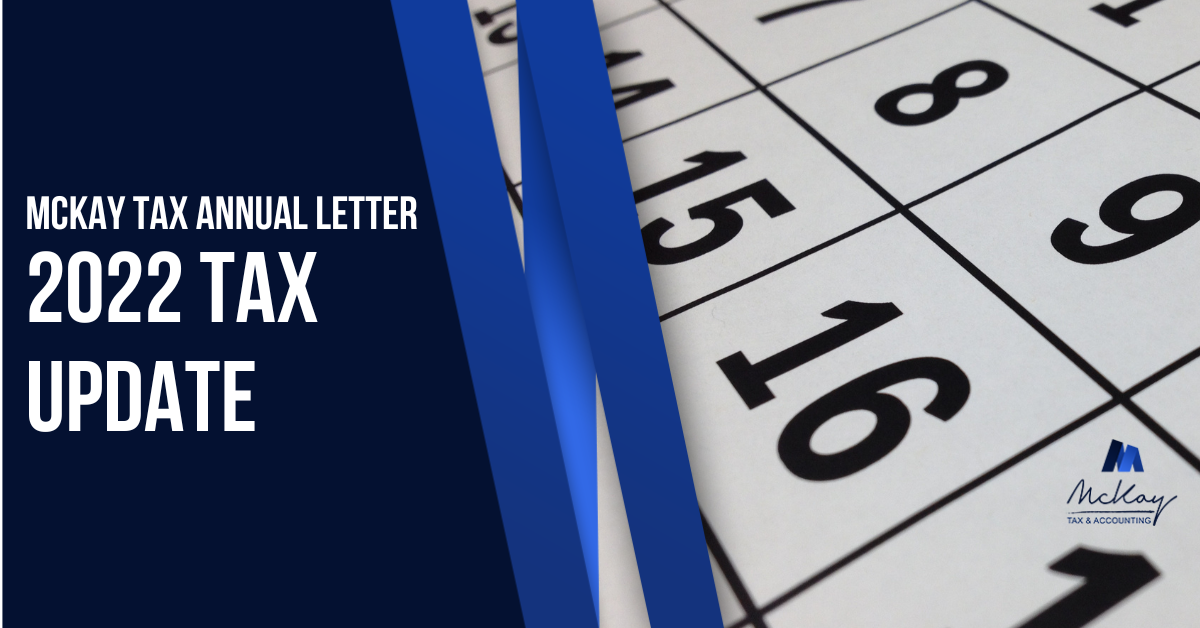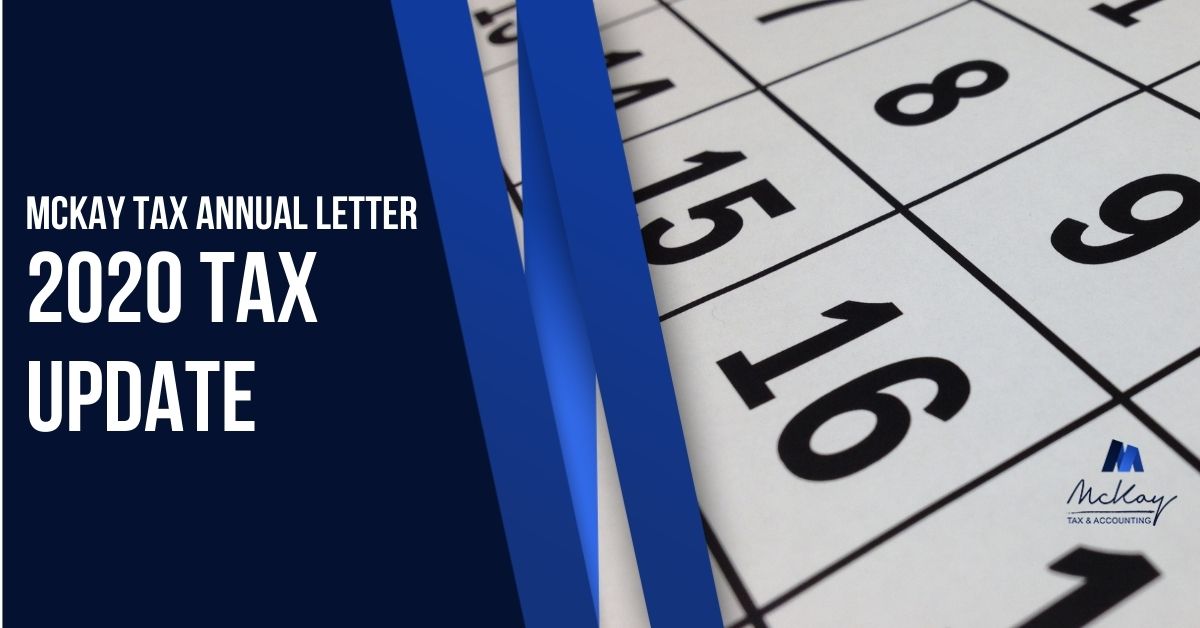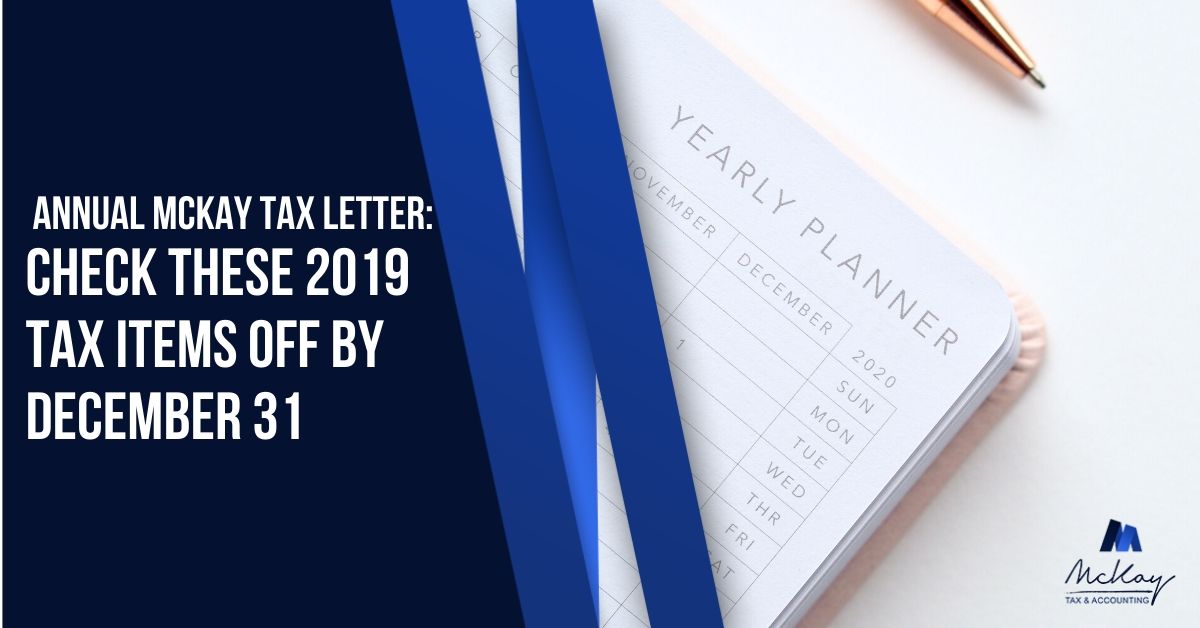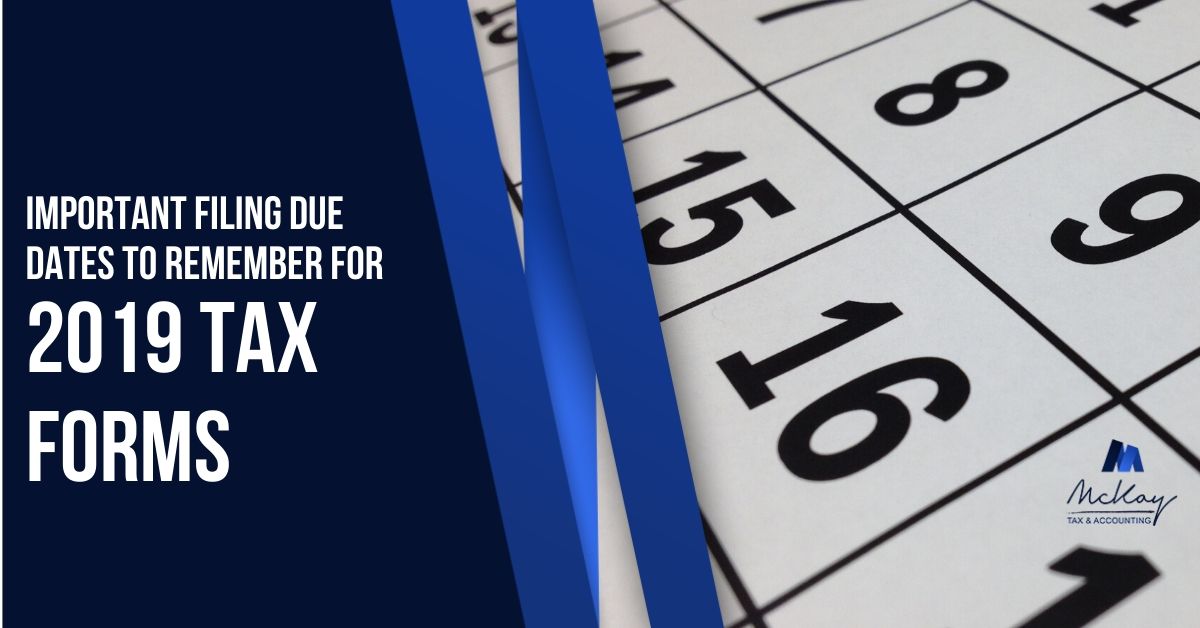McKay Tax Annual Letter: 2022 Tax Update
Below you will find your 2022 Tax Updates. Feel free to contact me if you have any questions.
2022 Standard Deductions
In 2022 Standard Deductions and Credits will return to the previous levels. The new 2022 standard deductions are $12,950 for single, $19,400 for the Head of Household, and $25,900 for those filing as Married/Jointly.
Child Tax Credit
The Child Tax Credit goes back to $2,000 (from 2021s 3,000 and 3,600) for dependents under 17 and $500 for dependents over 16. The higher tax credit for 17-year-old dependents from 2021 expired for 2022.
Child Care Credit
The Child Care Credit has changed. The Child Care Credit for 2021 had limits of 8,000 for one dependent and 16,000 for two dependents. For 2022, the Child Care Credit will go back to 3,000 for one dependent and 6,000 for two dependents.
Notable Business Changes
Business meals will remain 100% for 2022 but will return to 50% in 2023.
2022 Business miles reimbursements were 58.5 cents/mile until July 1. After July 1, business miles change to 62.5 cents/mile.
Year-End Tax Planning
Here are a few things to think about for year-end tax planning.
Charitable Donations
If you plan to itemize and need to make a trip to the DI or Salvation Army, do so before December 31. Be sure to get a receipt. Write down each item and the value of each item directly on your receipt.
Some taxpayers strategize by bunching charitable deductions in one year — meaning they itemize one year and take the standard deduction the following year. To do this, you would wait to pay your 2022 charity or make 2022 donations for the year you choose to itemize. Instead, make your donations in January 2023 and make any additional 2023 donations by December 31, 2023, to include your donations in one itemized year. In this example, you will get twice the deduction in one year (2023 as the itemized year) and take the standard deduction in 2022. You’ll want to choose the year that best serves your need for deductions.
You could also do this with other itemized deductions. For example, you can do this with medical expenses if you can group medical services into one year to maximize deduction value.
Flex-Spending Accounts
This time of the year is when employees must specify how much salary they will set aside in Flex Spending Accounts (section 125) for medical and child care expenses.
Using flex funds to pay for medical and child care expenses saves federal and state taxes and an additional 7.65% in FICA and Medicare taxes.
Be sure to estimate medical and child care expenses low.
Stock Sales
If you have underperforming stocks that you wouldn’t mind unloading, now is the time to offset any capital gains. Selling stocks at a loss can offset your capital gains for profitable stock sales throughout the year.
If you have a capital loss at the end of the year, you can carry that loss for later years and even write off up to $3,000 against your regular income for the year.
Choose what low-performing stocks you sell wisely. Wash sale rules don’t allow you to buy back into the same stock at a similar amount as your original sale for 31 days.
Retirement Planning
IRAs
Depending on your income, you can get a deduction for an IRA contribution in 2022. This deduction can be up to $6,000 if you are under 50 and $7,000 if you are over 50. Your IRA deduction will count even if you wait until Tuesday, April 18, 2023 (Tax Filing Day).
If you are required to take a 2022 minimum distribution from your IRA account, you can make that distribution payable to the charity of your choice tax-free if donated by December 31, 2022.
Roth IRAs
One of the best options out there for retirement planning is IRAs.
If your income for contributing to a Roth is over $125,000 for filing as Single or Head of Household or $198,000 for filing as joint married. Additionally, you do not have any other traditional IRAs. In that case, you can convert a non-deductible IRA to a Roth IRA with little or no tax due.
401(k) and Roth 401(k)
Usually, your employer will match all or part of your 401(k) contributions. Their matching contribution is essentially free money! To take advantage of this in tax planning, enroll in your company’s 401(k) and contribute up to the matching point.
Retirement Distributions
Please call me for the answers to your questions about early distributions from a retirement fund or planning your retirement. A simple phone call may save thousands of dollars in additional taxes and penalties.
That’s all the updates for the 2022 tax filing year!
Feel free to call me anytime for answers to your tax questions (including major events) at no additional cost.
Look for your appointment confirmation and questionnaire to arrive in the mail by January 5 or sooner.
Happy Holidays and have a wonderful New Year!
Sincerely,
Rich McKay
801-731-1857
RMcKay@McKayTax.com
This information is for educational purposes and is not intended to provide, and should not be relied upon for, accounting, legal, insurance, or investment advice. Any tax advice in this email reflects our professional judgment based on our understanding of the facts provided to us and on current tax law. Tax law is subject to change. Subsequent changes in the facts provided to us, the law, or its interpretation may affect this advice. We are not responsible for updating our advice for subsequent changes in the law or its interpretation. Please immediately contact the sender if you have received this message in error.










Recent Comments